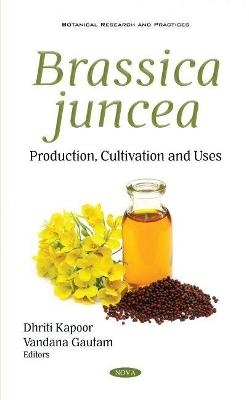
Brassica juncea
Production, Cultivation and Uses
Seiten
2021
Nova Science Publishers Inc (Verlag)
978-1-5361-9241-4 (ISBN)
Nova Science Publishers Inc (Verlag)
978-1-5361-9241-4 (ISBN)
Brassica juncea is a salient oilseed crop and contributes highest in domestic edible oils. It belongs to Brassicaceae family (Cruciferae). This annual herb is widely known for its adaptation to varying climatic conditions and manifest tolerance to diverse soil types. Most of Brassica species are diploid and amphidioploid. Brassica juncea (n=18) which is commonly known as Indian mustard. It is Asiatic in origin with prime centre of its diversity found in china from where it migrated to India via Afghanistan and other countries. Mustard is largely self-pollinated rabi season crop of temperate region, which relatively requires cool temperature for its growth and thrive well in irrigated and rainfed conditions. Seeds of mustard serve as a cheapest and healthiest source of oil in regular diet. Apart from its culinary purposes, it is also used in preparation of soaps, hair oils, lubricants, paints and as a condiment in pickles. Mustard oil extracted from this plant leads to the creation of by-product known as mustard cake, which is used as manure. This oil cake is used as cover crop for animal fodder due to its high protein and glucosinolate content. Brassica juncea plants are medicinally important source of phytochemical compounds of therapeutic significance. Brassica plants are studied for their bioactive potential and are reported to contain several other classes of alkaloids, tannins, saponins, anthocyanins, phytosterols, chlorophyll, glucosinolates, phytosteroids, terpenoids, glycosides, vitamin C, vitamin E, aliphatic and aromatic amines. Due to presence of these compounds, the plant displays anti-bacterial, anti-malarial, anti-hyperglycemic, anti-aging, anti-proliferative, anti-ulcer, anti-hyperlipidemic, anti-genotoxic, neuroprotective, antidiabetic and antioxidant activities. Brassica juncea has the potential to eliminate, detoxify or sequester heavy metals from polluted soil. Sequestrating ability of Brassica juncea pivots upon mobility of toxic substance, plant attribute and crop management aspects. The crop management aspects include above surface biomass of plants, intercropping, amendment of organic matter and incorporation of legumes for better phytoextraction via India mustard through boosting growth and soil metal dissipation. Brassica juncea are described as hyperaccumulator, as they are able to uptake high amount of heavy metals such as lead, copper, nickel from contaminated sites. The metal uptake by Brassica juncea is influenced by heavy metal availability in surroundings, rate of metal accumulation by roots, percentage of heavy metal fixed in the roots, rate of metal storing in xylem and transferring heavy metals to shoots and resistance of cells for heavy metals. Brassica juncea can effectively be cultivated and render soils contamination free. Assorted agronomic practices comprising irrigation, weed management, addition of fertilizers and chelators augments Brassica juncea potential. It exhibits noteworthy contribution in the world. Keeping these points in mind, various aspects like the botanical description, economic importance, cultivation practices, therapeutic potential and phytoremediation capacity of Brassica juncea has been described in this book. Apart from this, various breeding methods, genetic and molecular approaches have been well explained to improve the quality of this crop.
Preface; Botanical Characteristics and Economic Importance of Brassica juncea; Status, Cultivation and Usages of Indian Mustard: An Overview; Therapeutic Potential of Mustard Crop; Abiotic Factors and their Effects on Brassica Juncea Productivity; Assessment of the Phytoremediation Capacity of Brassica juncea; Accelerated Breeding: Doubled Haploids for Genetic Enhancement of Brassica juncea; Non-Chemical Based Management of Sclerotinia Rot of Rapeseed- Mustard (Brassica Spp.) Caused by Sclerotinia sclerotiorum; Advances in Agronomic Management and Cultivation Practices of Brassica juncea; Genetic and Biotechnological Approaches to Improve Seed Quality Traits in Indian Mustard; Index.
| Erscheinungsdatum | 19.03.2021 |
|---|---|
| Sprache | englisch |
| Gewicht | 542 g |
| Themenwelt | Naturwissenschaften ► Biologie ► Botanik |
| ISBN-10 | 1-5361-9241-4 / 1536192414 |
| ISBN-13 | 978-1-5361-9241-4 / 9781536192414 |
| Zustand | Neuware |
| Haben Sie eine Frage zum Produkt? |
Mehr entdecken
aus dem Bereich
aus dem Bereich
Gefäßpflanzen: Grundband
Buch | Hardcover (2021)
Springer Spektrum (Verlag)
44,99 €


